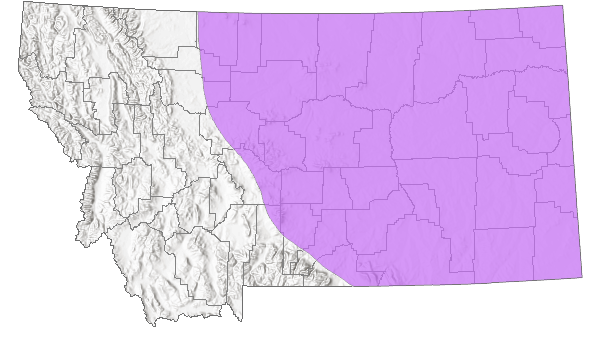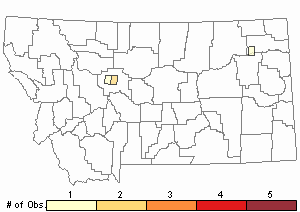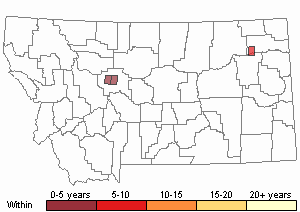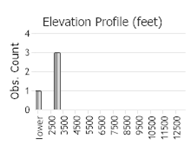View in other NatureServe Network Field Guides
NatureServe
Montana
Utah
Wyoming
Idaho
Wisconsin
British Columbia
South Carolina
Yukon
California
New York
Festive Tiger Beetle - Cicindela scutellaris
Native Species
Global Rank:
G5
State Rank:
S4
Agency Status
USFWS:
USFS:
BLM:
External Links
General Description
The following is taken from Wallis (1961), Kippenhan (1994), Knisley and Schultz (1997), Leonard and Bell (1999), Acorn (2001), and Pearson et al (2015). Body length is 11-14 mm. It is short-legged and robust, rear end rounded and elytra margins relatively parallel-sided. Above, generally brightly colored and quite variable, elytra from maroon and metallic orange or copper to green and black, head and thorax coppery to green, blue, purple, black. In some subspecies the head and thorax greatly contrasting with elytra. Maculations absent or reduced to spots or bands along outer edges of elytra. Undersides iridescent green-blue. Labrum white in males, dark or black in females, mandible with 3 teeth. Front and top of head with white hairs, less in females (hairs restricted to base of eyes) than males.
Phenology
Tiger beetle life cycles fit two general categories based on adult activity periods. “Spring-fall” beetles emerge as adults in late summer and fall, then overwinter in burrows before emerging again in spring when mature and ready to mate and lay eggs. The life cycle may take 1-4 years. “Summer” beetles emerge as adults in early summer, then mate and lay eggs before dying. The life cycle may take 1-2 years, possibly longer depending on latitude and elevation (Kippenhan 1994, Knisley and Schultz 1997, Leonard and Bell 1999). Adult Cicindela scutellaris a spring-fall species, active period is February to October but varies somewhat among subspecies (Larochelle and Larivière 2001, and Pearson et al. 2015). April to June and September to October in Nebraska and Ohio (Carter 1989, and Graves and Brzoska 1991), mid-March to early July and late August to late September in Colorado (Kippenhan 1994). In Montana, active at least from early April to early July and again September (Nate Kohler personal communication, and iNaturalist 2023).
Diagnostic Characteristics
The following comes largely from Kippenhan (1994), and Pearson et al. (2015). Most similar in the west and midwest to the Splendid Tiger Beetle (
C. splendida), but that species does not occur in Montana (although present in western South Dakota). It has a green to greenish-blue head and thorax and contrasting reddish elytra, similar to the
scutellaris subspecies of the Festive Tiger Beetle, but has a dull surface on the elytra with maculations reduced to a few lines and spots, not shiny and metallic, and usually immaculate. It also tends to occur on clay soils, not sand. The
C. scutellaris lecontei subspecies of the Festive Tiger Beetle, with its broad ivory-colored border along the outer edge of the elytra, is not likely confused with any other North American tiger beetle.
Species Range
Montana Range
Range Descriptions

 Native
Native
Range Comments
Cicindela scutellaris is widespread east of the Rocky Mountains, from the contiguous southern Canada south to the Gulf of Mexico and the southeastern Atlantic states. Absent from the Appalachian Mountains and the Mississippi River flood plain (Wallis 1961, Acorn 2001, Pearson et al. 2015). In Montana, the species is represented by two subspecies in the Great Plains: C. s. scutellaris throughout the region east of the Rocky Mountains, C. s. lecontei along the eastern border with the Dakotas.
Observations in Montana Natural Heritage Program Database
Number of Observations: 5
(Click on the following maps and charts to see full sized version)
Map Help and Descriptions
Relative Density

Recency



 (Observations spanning multiple months or years are excluded from time charts)
(Observations spanning multiple months or years are excluded from time charts)
Migration
Non-migratory but capable of dispersal. Wings fully developed (macropterous), good flier, fast runner (Larochelle and Larivière 2001).
Habitat
Adult and larval tiger beetle habitat essentially identical. The larvae live in soil burrows (Knisley and Schultz 1997). Across the range Cicindela scutellaris is associated with sandy soils and habitats with sparse vegetation. The more stabilized margins of sand dunes and dry grassy blowouts, sandy road cuts, sand flats, sand and gravel pits, riverine sand bars in the west, sandy soils beneath open pine and mixed pine-oak woodlands prior to later stages of succession in the east (Shelford 1907, Vaurie 1950, Wallis 1961, Hooper 1969, Knisley 1984, Carter 1989, Graves and Brzoska 1991, Kippenhan 1994, Acorn 2001, Larochelle and Larivière 2001, Kritsky and Smith 2005, Pearson et al. 2015). In Montana, habitat is poorly described but includes sand dunes, blowouts, and riverine sandbars, to at least 4200 ft (1280 m) elevation (Nate Kohler personal communication, and iNaturalist 2023).
Food Habits
Larval and adult tiger beetles are predaceous. In general, both feed considerably on ants (Wallis 1961, and Knisley and Schultz 1997). Diet of adult Cicindela scutellaris in the field includes live and dead ants, cutworms, beetles (carabids), grasshoppers (acridids), and dead lizards. In captivity, carabids, caterpillars, and dead fish. Diet of larvae in the field includes carabid larvae, gomphid and libellulid dragonflies, in captivity tenebrionid larvae (Larochelle and Larivière 2001).
Ecology
Larval tiger beetles live in burrows and molt through three instars to pupation, which also occurs in the larval burrow. Adults make shallow burrows in soil for overnight protection, deeper burrows for overwintering. Adults are sensitive to heat and light and are most active during sunny conditions. Excessive heat during midday on sunny days drives adults to seek shelter among vegetation or in burrows (Wallis 1961, Knisley and Schultz 1997).
Cicindela scutellaris has a narrow range of ecological tolerance (stenotopic). Adults are diurnal, especially in mid-day during the hottest periods, gregarious, very wary and often run through sparse vegetation, hide in slit holes in grassy sand areas on cloudy days (Vaurie 1950, Kippenhan 1994, Larochelle and Larivière 2001, and Pearson et al. 2015). Predators of adults include birds (American Crow, Burrowing Owl, Gray Catbird, grouse) and spiders, probably also robber flies (Asilidae). When disturbed makes fast looping flights of 3-4 m, also digs in sand. Emits a strong fruity scent when captured. Larvae often parasitized by bombyliid flies:
Anthrax sp. (Shelford 1908, Larochelle and Larivière 2001, Spomer and Spomer 2006, and Pearson et al. 2015). Associated tiger beetle species include
C. denverensis, a href="https://fieldguide.mt.gov/speciesDetail.aspx?elcode=IICOL02040" target="_blank>"
C. formosa,
C. lengi,
C. limbata,
C. sexgutta,
C. splendida, and
C. tranquebarica (Criddle 1907, Graves and Brzoska 1991, Kippenhan 1994, Larochelle and Larivière 2001, and Kritsky and Smith 2005). Coloration pattern of the
scutellaris subspecies may mimic the
toxic blister beetle, (
Lytta nuttalli) (Acorn 2001, and Larochelle and Larivière 2001).
Reproductive Characteristics
The life cycle of
Cicindela scutellaris is 2 years (Larochelle and Larivière 2001, and Pearson et al. 2015), both third-instar larvae and adults overwinter, adults emerging in fall, then overwintering and reemerging in spring to mate. Interspecific copulation observed with
C. formosa,
C. sexgutta and
C. tranquebarica. Mating is April to July for the subspecies occurring in Montana. Females dig oviposition holes 35-60 mm deep during the day; eggs laid in dry sand. Larval burrows are vertical and 25-71 cm deep, burrows are deeper in winter, and closed in mid-summer. Duration of larval life is 12-13 months, pupation in August in a chamber 25-50 mm deep branching 5-7 cm off of the main burrow. Fresh adults (tenerals) emerge in August and September (Criddle 1907, 1910, Shelford 1908, Vaurie 1950, Larochelle and Larivière 2001, and Brust et al. 2012). No information on reproductive characteristics for Montana.
Management
This species is not considered rare or in need of special conservation management except the subspecies Cicindela scutellaris yampae (Knisley et al. 2014), which is restricted to northwestern Colorado (Pearson et al. 2015). Sandy habitats favored by this species experience vegetation encroachment and stabilization as succession proceeds (Shelford 1907), and benefit from disturbance that retains a mosaic of successional conditions. Some colonies (particularly the larval burrows) could be impacted by trampling through livestock overgrazing, but grazing at appropriate times and stocking levels could also be beneficial by keeping vegetation cover more open (Knisley 2011). Prescribed fire in late autumn could also be a useful tool for sustaining habitat once larvae and adults are in overwinter burrows.
Stewardship Responsibility
References
- Literature Cited AboveLegend:
 View Online Publication
View Online Publication Acorn, J. 2001. Tiger beetles of Alberta: killers on the clay, stalkers on the sand. The University of Alberta Press, Edmonton, Alberta. 120 p.
Acorn, J. 2001. Tiger beetles of Alberta: killers on the clay, stalkers on the sand. The University of Alberta Press, Edmonton, Alberta. 120 p. Brust, M.L., C.B. Knisley, S.M. Spomer, and K. Miwa. 2012b. Observations of oviposition behavior among North American tiger beetle (Coleoptera: Carabidae: Cicindelinae) species and notes on mass rearing. The Coleopterists Bulletin 66(4):309-314.
Brust, M.L., C.B. Knisley, S.M. Spomer, and K. Miwa. 2012b. Observations of oviposition behavior among North American tiger beetle (Coleoptera: Carabidae: Cicindelinae) species and notes on mass rearing. The Coleopterists Bulletin 66(4):309-314. Carter, M. R. 1989. The biology and ecology of the tiger beetles (Coleoptera: Cicindelidae) of Nebraska. Transactions of the Nebraska Academy of Sciences XVII: 1-18.
Carter, M. R. 1989. The biology and ecology of the tiger beetles (Coleoptera: Cicindelidae) of Nebraska. Transactions of the Nebraska Academy of Sciences XVII: 1-18. Criddle, N. 1907. Habits of some Manitoba 'tiger beetles' (Cicindela). Canadian Entomologist 39:105-114.
Criddle, N. 1907. Habits of some Manitoba 'tiger beetles' (Cicindela). Canadian Entomologist 39:105-114. Criddle, N. 1910. Habits of some Manitoba tiger beetles (Cicindelidae). Canadian Entomologist 42(2):9-15.
Criddle, N. 1910. Habits of some Manitoba tiger beetles (Cicindelidae). Canadian Entomologist 42(2):9-15. Graves, R.C. and D.W. Brzoska. 1991. The tiger beetles of Ohio (Coleoptera: Cicindelidae). Bulletin of the Ohio Biological Survey New Series 8. 42 p.
Graves, R.C. and D.W. Brzoska. 1991. The tiger beetles of Ohio (Coleoptera: Cicindelidae). Bulletin of the Ohio Biological Survey New Series 8. 42 p. Hooper, R.R. 1969. A review of Saskatchewan tiger beetles. Cicindela 1(4):1-5.
Hooper, R.R. 1969. A review of Saskatchewan tiger beetles. Cicindela 1(4):1-5. iNaturalist. Research-grade Observations. Accessed 5 November 2023. https://www.inaturalist.org/
iNaturalist. Research-grade Observations. Accessed 5 November 2023. https://www.inaturalist.org/ Kippenhan, Michael G. 1994. The Tiger Beetles (Coleoptera: Cicindelidae) of Colorado. 1994. Transactions of the American Entomological Society 120(1):1-86.
Kippenhan, Michael G. 1994. The Tiger Beetles (Coleoptera: Cicindelidae) of Colorado. 1994. Transactions of the American Entomological Society 120(1):1-86. Knisley, C.B. 1984. Ecological distribution of tiger beetles (Coleoptera: Cicindelidae) in Colfax County, New Mexico. The Southwestern Naturalist 29(1):93-104.
Knisley, C.B. 1984. Ecological distribution of tiger beetles (Coleoptera: Cicindelidae) in Colfax County, New Mexico. The Southwestern Naturalist 29(1):93-104. Knisley, C.B. 2011. Anthropogenic disturbances and rare tiger beetle habitats: benefits, risks, and implications for conservation. Terrestrial Arthropod Reviews 4:41-61.
Knisley, C.B. 2011. Anthropogenic disturbances and rare tiger beetle habitats: benefits, risks, and implications for conservation. Terrestrial Arthropod Reviews 4:41-61. Knisley, C.B., and T.D. Schultz. 1997. The biology of tiger beetles and a guide to the species of the south Atlantic states. Virginia Museum of Natural History Special Publication Number 5. 210 p.
Knisley, C.B., and T.D. Schultz. 1997. The biology of tiger beetles and a guide to the species of the south Atlantic states. Virginia Museum of Natural History Special Publication Number 5. 210 p. Knisley, C.B., M. Kippenhan, and D. Brzoska. 2014. Conservation status of United States tiger beetles. Terrestrial Arthropod Reviews 7:93-145.
Knisley, C.B., M. Kippenhan, and D. Brzoska. 2014. Conservation status of United States tiger beetles. Terrestrial Arthropod Reviews 7:93-145. Kohler, Nathan S. Excel spreadsheets of tiger beetle observations. 6 August 2022.
Kohler, Nathan S. Excel spreadsheets of tiger beetle observations. 6 August 2022. Kritsky, G. and J. Smith. 2005. Teddy's tigers: the Cicindelidae (Coleoptera) of Theodore Roosevelt National Park, North Dakota. Cicindela 37(1-2):1-16
Kritsky, G. and J. Smith. 2005. Teddy's tigers: the Cicindelidae (Coleoptera) of Theodore Roosevelt National Park, North Dakota. Cicindela 37(1-2):1-16 Larochelle, A and M Lariviere. 2001. Natural history of the tiger beetles of North America north of Mexico. Cicindela. 33:41-162.
Larochelle, A and M Lariviere. 2001. Natural history of the tiger beetles of North America north of Mexico. Cicindela. 33:41-162. Leonard, Jonathan G. and Ross T. Bell, 1999. Northeastern Tiger Beetles: a field guide to tiger beetles of New England and eastern Canada. Boca Raton, FL: CRC Press. 176 p.
Leonard, Jonathan G. and Ross T. Bell, 1999. Northeastern Tiger Beetles: a field guide to tiger beetles of New England and eastern Canada. Boca Raton, FL: CRC Press. 176 p. Pearson, D.L., C.B. Knisley, D.P. Duran, and C.J. Kazilek. 2015. A field guide to the tiger beetles of the United States and Canada, second edition. New York, NY: Oxford University Press. 251 p.
Pearson, D.L., C.B. Knisley, D.P. Duran, and C.J. Kazilek. 2015. A field guide to the tiger beetles of the United States and Canada, second edition. New York, NY: Oxford University Press. 251 p. Shelford, V.E. 1907. Preliminary note on the distribution of the tiger beetles (Cicindela) and its relation to plant succession. Biological Bulletin 14:9-14.
Shelford, V.E. 1907. Preliminary note on the distribution of the tiger beetles (Cicindela) and its relation to plant succession. Biological Bulletin 14:9-14. Shelford, V.E. 1908. Life-histories and larval habits of the tiger beetles (Cicindelidae). The Journal of the Linnean Society 30:157-184.
Shelford, V.E. 1908. Life-histories and larval habits of the tiger beetles (Cicindelidae). The Journal of the Linnean Society 30:157-184. Spomer, S.M. and D.T. Spomer. 2006. Burrowing owl as a predator of Cicindela scutellaris Say. Cicindela 38(1-4):63-64.
Spomer, S.M. and D.T. Spomer. 2006. Burrowing owl as a predator of Cicindela scutellaris Say. Cicindela 38(1-4):63-64. Vaurie, P. 1950. Notes on the habitats of some North American tiger beetles. Journal of the New York Entomological Society 58(3):143-153.
Vaurie, P. 1950. Notes on the habitats of some North American tiger beetles. Journal of the New York Entomological Society 58(3):143-153. Wallis, J.B. 1961. The Cicindelidae of Canada. Toronto, Ontario, Canada: University of Toronto Press. 74 p.
Wallis, J.B. 1961. The Cicindelidae of Canada. Toronto, Ontario, Canada: University of Toronto Press. 74 p.
- Additional ReferencesLegend:
 View Online Publication
View Online Publication
Do you know of a citation we're missing? Bousquet, Yves. 2012. Catalogue of Geadephaga (Coleoptera; Adephaga) of America north of Mexico. ZooKeys. 245:1-1722.
Bousquet, Yves. 2012. Catalogue of Geadephaga (Coleoptera; Adephaga) of America north of Mexico. ZooKeys. 245:1-1722. Pearson, D.L., C.B. Knisley, and C.J. Kazilek. 2006. A field guide to the tiger beetles of the United States and Canada: identification, natural history, and distribution of the Cicindelidae. Oxford University Press, New York, New York. 227 pp.
Pearson, D.L., C.B. Knisley, and C.J. Kazilek. 2006. A field guide to the tiger beetles of the United States and Canada: identification, natural history, and distribution of the Cicindelidae. Oxford University Press, New York, New York. 227 pp.
- Web Search Engines for Articles on "Festive Tiger Beetle"
- Additional Sources of Information Related to "Insects"





